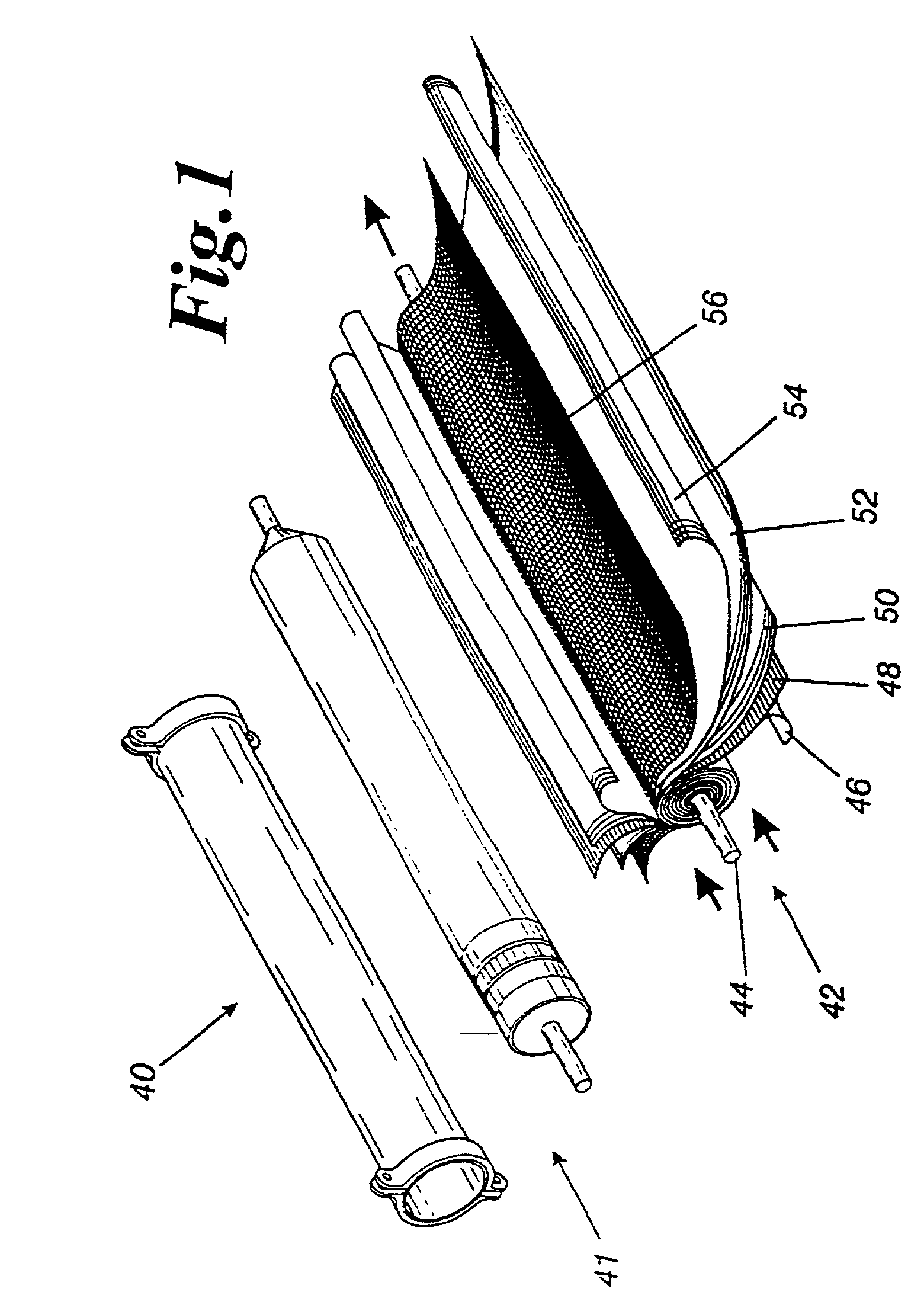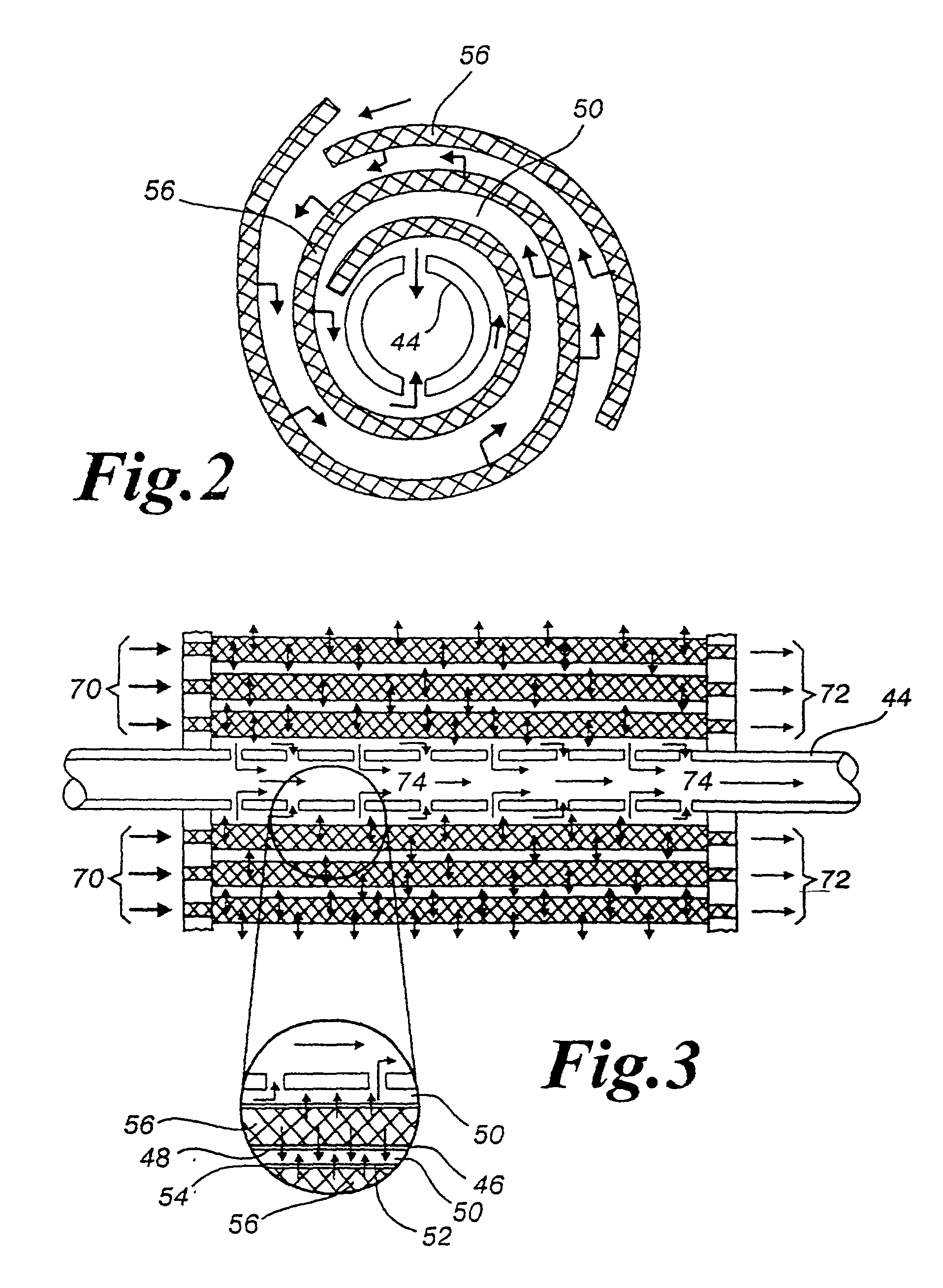Antimicrobial semi-permeable membranes
- Summary
- Abstract
- Description
- Claims
- Application Information
AI Technical Summary
Benefits of technology
Problems solved by technology
Method used
Image
Examples
example 1
[0054] Four cellulose acetate membranes were formed from a dope solution comprising the following constituents:
1 Weight Percentage: 51.1% Dioxane 20.4% Acetone 10.8% Cellulose Diacetate 7.2% Cellulose Triacetate 7.8% Methanol 2.7% Maleic Acid
[0055] The above dope solution contains about 18% cellulose polymer solids. The four cellulose acetate membranes were cast with MICROBAN.RTM. Additive B concentrations at 2,500,5,000, 10,000 and 20,000 ppm by weight based upon the approximate total cellulose polymer content of about 18%.
[0056] The cast cellulose acetate membranes were analyzed for MICROBAN.RTM. Additive B using gas chromatography, the results of which are shown below in Table 1.
2TABLE 1 MICROBAN .RTM. Additive B MICROBAN .RTM. Additive B Content In Dope Content In Cellulose Solution (ppm of polymer solids) Acetate Membrane (ppm) 2,500 2,350 5,000 4,500 10,000 9,200 20,000 18,500
[0057] The test results shown in Table 1, confirm that at least 90% of the antimicrobial agent was pre...
example 2
[0061] FIG. 4 is a schematic cross section of a thin-film composite polyamide reverse osmosis membrane, shown generally at membrane 10, in accordance with the present invention. To form the composite polyamide reverse osmosis membrane 10, a dope solution of polysulfone was prepared in dimethyl formamide (DMF) solvent. The polysulfone used was sold under the trade name "U.C.P. 1700" by Union Carbide. The dope solution contains about 18% polysulfone by weight and MICROBAN.RTM. Additive B of about 2% of the weight of the polysulfone. The dope solution was then deposited onto a reinforcing fabric of polyester 12 that was approximately 120 microns thick. A precipitating bath containing water and about 0.5% sodium dodecyl sulfate was maintained at 4.degree. C., and the polyester fabric 12 was carried by a moving belt that for a portion of its circuit was immersed in water. The dope solution was deposited onto the moving reinforcing polyester fabric 12 behind a doctoring blade. As the fabr...
example 3
[0066] The use of polysulfone as the primary constituent for a substantially planar semi-permeable membrane as described in Example 2, is also applicable to filter modules incorporating hollow, thin polymer fibers that preferably comprise polysulfone and polyvinylidene fluoride and that incorporate an antimicrobial agent therein. Three dope solutions ofpolyvinylidene fluoride, commercially available as Kynar Grade 460 and marketed by Elf Atochem North America, were prepared as follows:
4 Dope Dope Dope Solution I Solution II Solution III 1) Polyvinylidene fluoride 16% 16% 16% 2) Polyvinyl pyrrollidone 4% 4% 4% 3) Zinc Chloride 4% 4% 4% 4) Microban Additive B 1.9% 0.96% 0.48% 5) N-methyl pyrrollidone solvent 74.1% 75% 75%
[0067] A polyester support tube woven from polyester filament fiber into a continuous tube was used to make this fiber. The inside diameter of the polyester tube was about 1.6 mm. FIG. 6 is a schematic diagram of a polyester tube 62 that is dipped into a vessel 61 con...
PUM
| Property | Measurement | Unit |
|---|---|---|
| Fraction | aaaaa | aaaaa |
| Percent by mass | aaaaa | aaaaa |
| Size | aaaaa | aaaaa |
Abstract
Description
Claims
Application Information
 Login to View More
Login to View More - R&D
- Intellectual Property
- Life Sciences
- Materials
- Tech Scout
- Unparalleled Data Quality
- Higher Quality Content
- 60% Fewer Hallucinations
Browse by: Latest US Patents, China's latest patents, Technical Efficacy Thesaurus, Application Domain, Technology Topic, Popular Technical Reports.
© 2025 PatSnap. All rights reserved.Legal|Privacy policy|Modern Slavery Act Transparency Statement|Sitemap|About US| Contact US: help@patsnap.com



